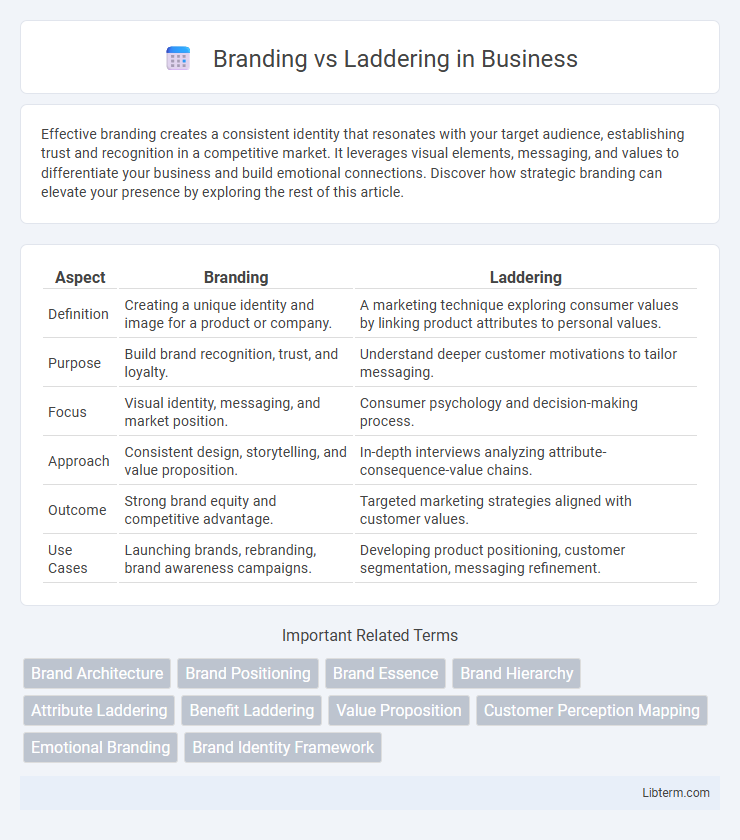Effective branding creates a consistent identity that resonates with your target audience, establishing trust and recognition in a competitive market. It leverages visual elements, messaging, and values to differentiate your business and build emotional connections. Discover how strategic branding can elevate your presence by exploring the rest of this article.
Table of Comparison
| Aspect | Branding | Laddering |
|---|---|---|
| Definition | Creating a unique identity and image for a product or company. | A marketing technique exploring consumer values by linking product attributes to personal values. |
| Purpose | Build brand recognition, trust, and loyalty. | Understand deeper customer motivations to tailor messaging. |
| Focus | Visual identity, messaging, and market position. | Consumer psychology and decision-making process. |
| Approach | Consistent design, storytelling, and value proposition. | In-depth interviews analyzing attribute-consequence-value chains. |
| Outcome | Strong brand equity and competitive advantage. | Targeted marketing strategies aligned with customer values. |
| Use Cases | Launching brands, rebranding, brand awareness campaigns. | Developing product positioning, customer segmentation, messaging refinement. |
Introduction to Branding and Laddering
Branding establishes a unique identity for products or services by creating consistent visual elements, messaging, and emotional connections with the target audience. Laddering is a qualitative research technique that uncovers underlying consumer motivations by linking product attributes to personal values through a series of probing questions. Combining branding with laddering enhances marketing strategies by aligning brand messages with deep customer insights and values.
Defining Branding: Core Concepts
Branding centers on creating a unique identity for a product or company by emphasizing its core values, visual elements, and emotional appeal to foster customer recognition and loyalty. It involves strategic use of logos, slogans, and consistent messaging to differentiate from competitors and communicate the brand promise effectively. Successful branding establishes trust, influences consumer perceptions, and supports long-term business growth through meaningful connections with target audiences.
Understanding Laddering: An Overview
Laddering is a qualitative research technique used to uncover the deep personal values that drive consumer behavior by linking product attributes to functional and emotional benefits. This method involves probing through hierarchical questioning to reveal the connections between specific features, the consequences of those features, and the core values they satisfy. Understanding laddering helps marketers create branding strategies that resonate on a deeper psychological level, fostering stronger consumer loyalty and preference.
Key Differences between Branding and Laddering
Branding centers on creating a unique identity and emotional connection through logos, slogans, and consistent messaging, while laddering aims to uncover deeper consumer values by linking product attributes to personal motivations via structured interviewing techniques. Branding focuses on external perception and market positioning, whereas laddering delves into internal cognitive structures driving consumer decisions. The primary difference lies in branding's emphasis on strategic communication and recognition, compared to laddering's qualitative research approach to understanding consumer psychology.
The Strategic Role of Branding in Marketing
Branding establishes a unique identity and emotional connection that differentiates products in competitive markets, driving customer loyalty and long-term value. Laddering uncovers consumer motivations by linking product attributes to personal values, enhancing brand messaging precision. Strategic branding integrates these insights to create compelling narratives that resonate deeply, boosting market positioning and profitability.
How Laddering Enhances Consumer Insights
Laddering enhances consumer insights by uncovering the deeper emotional and psychological motivations behind purchasing decisions through a structured interview technique. This method links tangible product attributes to personal values, allowing brands to tailor their messaging and positioning more effectively. Understanding these connections helps marketers create targeted branding strategies that resonate on a meaningful level with consumers.
Applications of Branding vs Laddering in Business
Branding establishes a unique identity and emotional connection with customers by consistently communicating values, mission, and visual elements, driving customer loyalty and market differentiation. Laddering, used mainly in market research, uncovers consumers' deeper motivations and beliefs by linking product attributes to personal values, enhancing targeted marketing strategies and product positioning. Businesses apply branding for long-term equity building, while laddering informs message development and innovation through insights into consumer decision-making processes.
Common Challenges in Branding and Laddering
Common challenges in branding include establishing a unique brand identity, maintaining consistency across diverse channels, and effectively communicating value to target audiences. Laddering faces difficulties in uncovering deep consumer motivations, accurately linking product attributes to emotional benefits, and interpreting qualitative data for actionable insights. Both approaches require overcoming barriers related to customer perception and ensuring strategic alignment with market demands.
Best Practices for Integrating Branding and Laddering
Integrating branding and laddering requires aligning emotional brand values with consumer cognitive structures, ensuring consistent messaging that resonates deeply with target audiences. Best practices include conducting thorough laddering interviews to uncover underlying motivations and translating these insights into compelling brand narratives that reinforce brand identity at every touchpoint. Consistent application across marketing channels strengthens brand loyalty by connecting functional attributes to personal values effectively.
Conclusion: Choosing the Right Approach
Selecting the right approach depends on your marketing objectives and target audience insights; branding emphasizes building a strong, recognizable identity, while laddering dives deeper into uncovering underlying consumer motivations and values. For long-term brand equity, prioritizing branding strategies ensures consistency and emotional connection, whereas laddering provides detailed, motivational understanding useful for tailoring messaging in niche markets. Combining both approaches can optimize consumer engagement by balancing broad brand appeal with specific psychological drivers.
Branding Infographic

 libterm.com
libterm.com